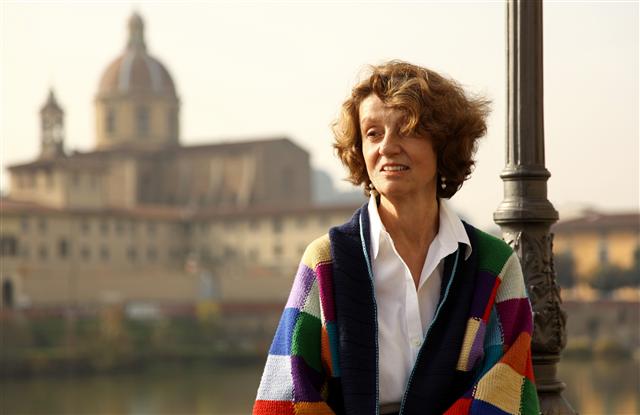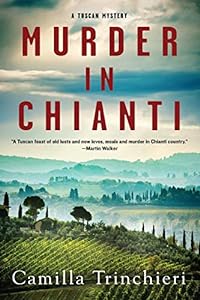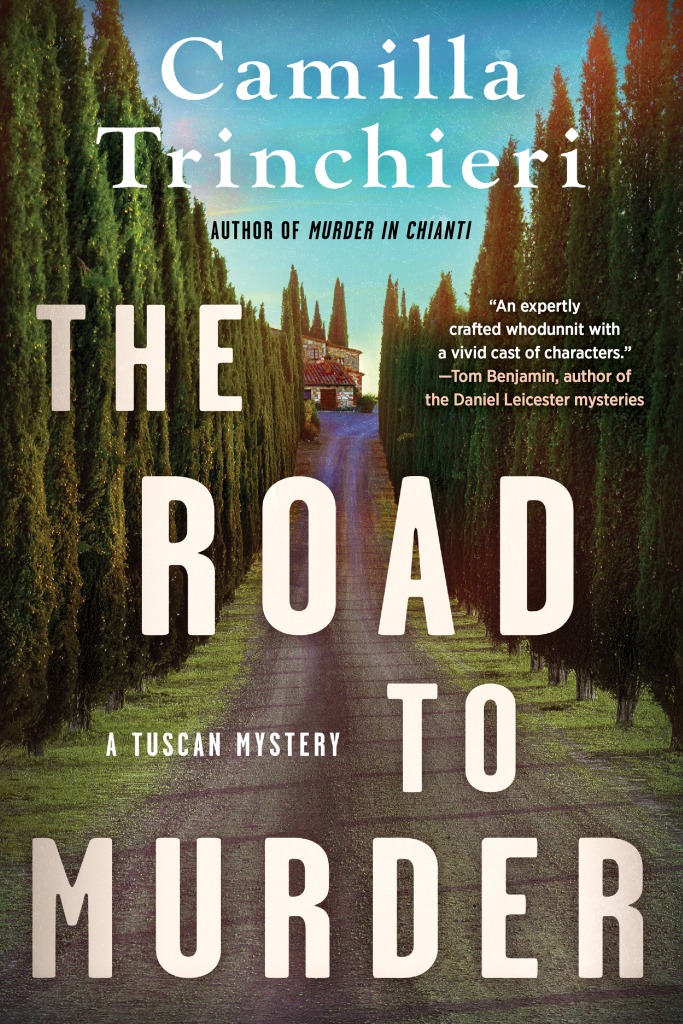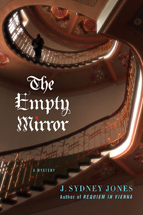Camilla Trinchieri is the author of the Tuscan Mysteries series, launched in 2020 with Murder in Chianti. This series features the former NYPD detective Nico Doyle, who has left detective work behind, moving to the Italian hometown, Gravigna, of his deceased wife, Rita, and hoping to find some peace. The village is in the Chianti region, and Nico, half-Italian and half-Irish, slowly builds a new life working with Rita’s relatives. But soon he is also pulled back into the world of policing, recruited by the local Maresciallo, or marshal, Salvatore Perillo, to aid in a murder investigation in quiet and peaceful Gravigna.
As the series progresses, Nico aids in several further investigations with both Perillo and Brigadier Daniele Donato, and also continues to build his new life and home with his dog, OneWag. Over the course of time, Nico becomes a beloved member of the community, and even finds a new special person in his life in this village in Chianti.
The series, now four-books strong, has won praise from reviewers from its launch onward. A Publishers Weekly critic called Murder in Chianti a “vibrant mystery” with “enticing descriptions of food and wine,” while Kirkus dubbed that series launch an “engaging procedural that introduces a delightful cast of characters readers will want to spend more time with.”
The series now stands at four novels, with The Bitter Taste of Murder published in 2021, Murder on the Vine from 2022; and The Road to Murder from 2024. Along the way, the series has continued to gain new readers and excellent reviews, often compared to the Venetian procedurals of Donna Leon and the Chief Inspector Gamache works of Louise Penny.
The author, Trinchieri, has herself lived a life worthy of a novel. She was born in Prague to an Italian diplomat father and American mother, moved to the U.S. with her parents when she was twelve, and then after graduating from Banard College, moved to Italy. There she lived in Rome and worked in the film industry as a dubbing producer and director on films from Federico Fellini, Luchino Visconti, Lina Wertmüller and many others. Then back to the United States where she married, became a U.S.citizen, and earned an MFA from Columbia University’s renowned Graduate Writing Program.
Trinchieri has published numerous other novels both under her own name and writing as Camilla Crespi, including seven novels in the Simona Griffo Mystery Series.
Camilla, welcome to Scene of the Crime. I’ve been looking forward to talking with you about your excellent Tuscan Mysteries series. Let’s start things off with your connection to Italy and Chianti.
My first connection is being Italian. I discovered my Chianti town one summer while town-hopping though Tuscany. Something about the place drew me in a way I hadn’t experienced in other towns. I knew I wanted to place a story in this town without really knowing why. It didn’t matter. I have always let my gut feelings lead me. Having only lived in cities, I knew nothing about town life so the year I went back I stayed for a month. I have gone back every year, staying for two or three weeks each time.
What things about Gravigna make it unique and a good physical setting in your books?
It’s a simple town, beautifully situated above a valley covered with vineyards and surrounded by verdant hills beloved by cyclists. It is a feast for the eyes, but so are many more beautiful towns. It is unique to me because I discovered warm, welcoming people, many of whom have become friends. The town has become my home away from home.
Did you consciously set out to use your location as a “character” in your books, or did this grow naturally out of the initial story or stories?
I think it would be hard to write about any place in Italy without it being a character. Gravigna was my first character, then my stories spread out to neighboring towns and the surrounding landscapes. As I write, I go where Nico and OneWag, the Maresciallo and Daniele go. I walk the streets with them, follow them, listen to them with my eyes taking in where they are, what they see.
How do you incorporate location in your fiction? Do you pay overt attention to it in certain scenes, or is it a background inspiration for you?
I developed a strong sense of place as a child. My father was an Italian diplomat. Growing up I changed countries, schools, languages. I learned to study my new surroundings, to assess where I was in order to place myself there quickly. I try to place my characters so that the reader is in the same place with them, seeing and hearing, and I hope, feeling what they are feeling. I don’t think of myself as being conscious of referring to my town in an overt way. I am just there with my characters, watching and listening to them.
How does Nico interact with his surroundings and vice versa?
Nico first interacts with his deceased wife’s cousin, who runs Sotto Il Fico, a local restaurant. The restaurant setting recurs throughout the stories as Nico enthusiastically starts cooking. I suspect he would have been happy to stay in that kitchen, and after work grow vegetables in his garden, enjoy the small farmhouse he has rented, and have breakfast with Gogol, his Dante quoting friend at Bar Al Angolo, another setting where Nico is welcomed and made to feel at home. I think that by moving to Gravigna, Nico expected a quiet life far from the murders he had to deal with back in New York. It’s a dog’s cry that gets him further into the life of the town. He finds a body. At first reluctant to help Maresciallo Perillo solve the murder, Nico accepts the job. By doing so he becomes one of the town, part of the setting. The setting helps him stop grieving, gives him a new life.
Has there been any local reaction to your works? What do the residents of Gravigna think about these books?
Local reaction has been wonderful, despite the books not being read as only a few townspeople read English. I think they get a kick about being featured in American books. A weekly Chianti newspaper wrote a nice article about the mysteries. The Italian publisher who had brought out three other books of mine thought the Chianti mysteries were too oriented toward foreigners and so declined to have them translated. I agree with her, although I would love to have my Chianti friends read them.
Have you ever made any goofs in depicting your location or time period? Please share–the more humorous the better (we all have).
I am sure I have made many goofs, mostly in the area of Italian criminal law despite the help I received from the Greve-in-Chianti maresciallo. Since the mysteries have not been translated, my goofs have not been spotted.
Of the novels you have written set in this location, do you have a favorite book or scene that focuses on the place? Could you quote a short passage or give an example of how the location figures in your novels?
From Murder in Chianti:
The air was still chilly at that hour, a fact Nico welcomed as he set off for his three-mile run along the winding road that led up to Gravigna. It was steep going and dangerous in the predawn light. Even at that hour cars kept whizzing past in both directions on their way to work.
When the town appeared, perched on its own small hill, Nico stopped to catch his breath and take in the view of the old town of Gravigna, with its medieval castle walls, its two towers, the proud steeple of the Sant’Agnese Church. In the meager predawn light Nico could, with the help of memory, make out the hundreds of neat rows of vines that covered the Conca d’Oro, the golden bowl below the town that had once only grown grain….
Who are your favorite writers, and do you feel that other writers influenced you in your use of the spirit of place in your novels?
My love for mysteries started with Agatha Christie and Rex Stout. Through the years Tana French, Aaron Elkins, Laura Lippman, Ann Cleeves and many, many others. I am sure they all have influenced me in one way or another. For one thing, they make me want to write well.
If you could live anywhere, where would it be and why?
La bella Italia. In Panzano, with occasional trips to Rome, my old home and where I have family. I left Italy for New York many years ago, but it is still very much in my heart.
What’s next for Nico?
A murder in the medieval town of Pitigliano, also known as Little Jerusalem. Nico is hired by a woman who wants her partner, the father of her child, cleared of the murder of his business partner.
Camilla, many thanks for joining us at Scene of the Crime. It’s been a pleasure. Looking forward to further installments of this fine series.











